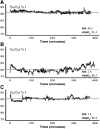Acute Altitude Acclimatization in Young Healthy Volunteers: Nocturnal Oxygenation Increases Over Time, Whereas Periodic Breathing Persists
- PMID: 33185483
- PMCID: PMC8035920
- DOI: 10.1089/ham.2020.0009
Acute Altitude Acclimatization in Young Healthy Volunteers: Nocturnal Oxygenation Increases Over Time, Whereas Periodic Breathing Persists
Abstract
Ju, Jia-Der, Cristian Zhang, Francis P. Sgambati, Lidia M. Lopez, Luu V. Pham, Alan R. Schwartz, and Roberto A. Accinelli. Acute altitude acclimatization in young healthy volunteers: nocturnal oxygenation increases over time whereas periodic breathing persists. High Alt Med Biol. 22:14-23, 2021. Study Objectives: This study aimed to examine the acute effects of high altitude (HA) on sleep disordered breathing (sleep apnea and nocturnal hypoxemia) and acute mountain sickness and to characterize acclimatization over time. Methods: Ten native lowlanders residing at sea level (SL) completed the Lake Louise Score (LLS) and underwent nocturnal polygraphy (ApneaLink Plus) for nine consecutive nights (N1-N9) at HA (2,761 m) and two nights before and after HA. Nocturnal oxygen profiles were assessed by measuring the mean nocturnal oxyhemoglobin saturation (SpO2) during sleep, and sleep apnea severity as assessed by measuring the Apnea-Hypopnea Index (AHI). Mixed-effects linear regression was used to model responses in outcomes (mean nocturnal SpO2, logAHI, and LLS) between HA and SL. Changes in SpO2 and AHI were examined in subgroups with mild versus marked nocturnal SpO2 and low versus high AHI during exposure to HA and compared between subgroups. Results: Compared with SL, the mean nocturnal SpO2 was lower (p < 0.0001) and AHI was higher (p < 0.0001) at HA. The mean nocturnal SpO2 increased progressively (p < 0.001), whereas AHI remained high (p < 0.978) and relatively unchanged over nine successive nights at HA. Those with markedly reduced SpO2 upon arrival at HA exhibited progressive increases in the mean nocturnal SpO2 over time at HA compared with those with mild nocturnal desaturation. LLS rose at HA, but no differences were observed between subgroups. Conclusions: In healthy HA sojourners, the mean nocturnal SpO2 increased progressively over time, whereas AHI remained elevated, suggesting distinctive phenotypes and acclimatization responses to HA.
Keywords: high altitude; sleep; sleep disordered breathing.
Conflict of interest statement
None of the authors have any relevant conflicts of interest to disclose. All the authors of this article have properly seen, reviewed, and approved the article before the submission.
Figures





References
-
- Ainslie PN, Lucas SJ, and Burgess KR. (2013). Breathing and sleep at high altitude. Respir Physiol Neurobiol 188:233–256 - PubMed
-
- Berry RB, Brooks R, Gamaldo CE, Harding SM, Lloyd RM, Marcus CL, and Vaughn BV. (2016). The AASM Manual for the Scoring of Sleep and Associated Events: Rules, Terminology and Technical Specifications. American Academy of Sleep Medicine
-
- Burgess KR, Johnson P, Edwards N, and Cooper J. (2004). Acute mountain sickness is associated with sleep desaturation at high altitude. Respirology 9:485–492 - PubMed
-
- Casey KR, Cantillo KO, and Brown LK. (2007). Sleep-related hypoventilation/hypoxemic syndromes. Chest 131:1936–1948 - PubMed
-
- Douglas NJ, White DP, Weil JV, Pickett CK, Martin RJ, and Hudgel DW. (1982a). Hypoxic ventilatory response decreases during sleep in normal men. Am Rev Respir Dis 125:286–289 - PubMed
MeSH terms
Grants and funding
LinkOut - more resources
Full Text Sources
Other Literature Sources
Medical

